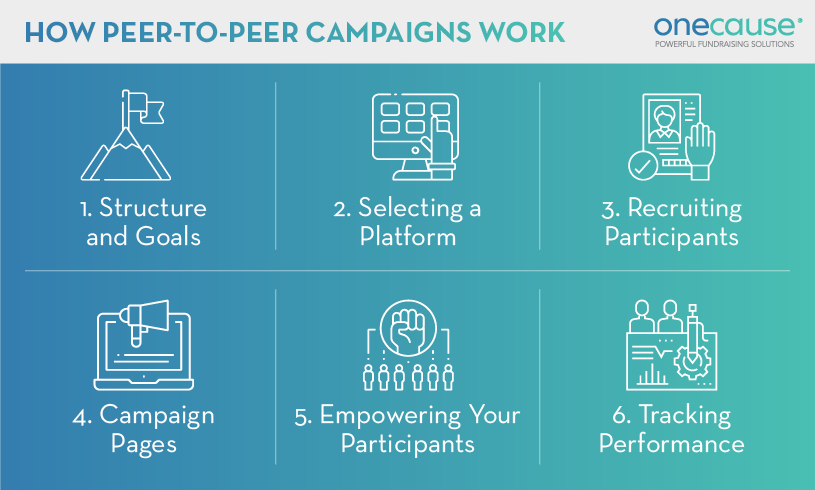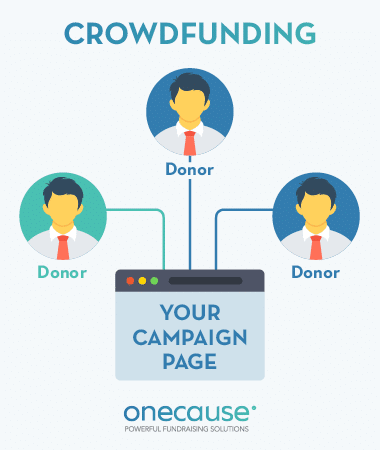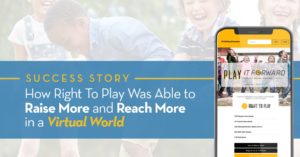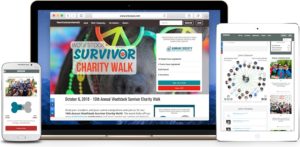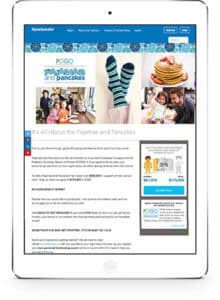What is Peer-to-Peer Fundraising? A Complete Crash Course
There’s a lot of peer-to-peer potential for your mission!
In recent years, we’ve seen the incredible impact that a strong peer-to-peer strategy can have in traditional, online, and hybrid formats. An estimated 27% of US adults gave through social fundraisers in 2020-2021, and these campaigns are attracting younger and more diverse donors than ever before (The OneCause Giving Experience Study).
What is Peer-to-Peer Fundraising?
Peer-to-peer fundraising, also called social or team fundraising, is an online fundraising technique in which individual supporters or ambassadors fundraise on behalf of a larger cause or organization. These volunteer fundraisers promote the campaign to their own networks of friends and family online.
The peer-to-peer fundraising structure is different from more traditional campaigns in which an organization directly asks its supporters and online audience for donations. The more indirect approach of peer-to-peer fundraising allows the organization to reach much larger audiences and boost its online visibility in an organic way.
Peer-to-peer fundraising is also referred to as P2P, social, team, and peer-based fundraising.
Ready to tap into the power of peer-to-peer fundraising? We’ll dig into the extensive benefits of peer-to-peer fundraising and examples of successful campaigns below, but for now, let’s start with the basics.
Here's what we'll cover:
Peer-to-Peer Fundraising FAQ
What are the types of peer-to-peer fundraising?
Peer-to-peer fundraising campaigns typically fall into a few general categories, including:
- Awareness and giving campaigns
- DIY-style campaigns
- Ambassador campaigns
- Challenge campaigns
- On-the-ground events, like runs, walks, and rides
- Virtual peer-to-peer campaigns
Learn more about each of these variations of peer-to-peer fundraising with these breakdowns from OneCause.
Can peer-to-peer fundraising be used in virtual and hybrid formats?
Peer-to-peer fundraising is extremely flexible. Since it’s driven by online engagement, especially on social media, these campaigns are a perfect choice for virtual formats. Depending on the scope and goals of your campaign, you can also incorporate a range of in-person and hybrid events to keep supporters excited and drive year-round engagement.
Who can use peer-to-peer fundraising strategies?
Organizations of all sizes succeed with peer-to-peer fundraising! When planned well, these campaigns can be cost-effective, meaning nonprofits, schools, churches, community organizations, and any other causes can make use of them. The key is to carefully adapt your plans to your unique audience and find touchpoints to actively support your fundraisers along the way.
What peer-to-peer fundraising tools do I need?
Start with the right peer-to-peer fundraising software, which will enable you (and your supporters) to create individual donation pages. This will be the foundation of your entire campaign, as it helps with the planning process, makes donations easy, and provides useful campaign insights. You’ll also need an active social media presence, ambassador fundraising strategy, and email capabilities to help promote your campaign.
How Peer-to-Peer Fundraising Works
Peer-to-peer fundraising is extremely flexible, so you can customize your campaign to meet your nonprofit’s mission, culture, and donor base. However, every campaign follows these core steps:
- Decide on your peer-to-peer campaign’s structure and goals.
- Select your peer-to-peer fundraising platform.
- Recruit your peer-to-peer fundraisers.
- Set up your campaign page(s).
- Empower your peer-to-peer fundraising participants.
- Keep up with your campaign by tracking performance.
Let’s take a closer look at each of these steps:
Step 1: Decide on your P2P campaign’s structure and goals.
Determine how you want your campaign to work and define your specific fundraising goals. How much do you want to raise? What’s your budget? Will you tie your fundraiser to an in-person, virtual, or hybrid event? Will you recruit ambassadors or allow anyone to launch their own giving page?
Step 2: Select your peer-to-peer fundraising platform.
The right fundraising software is essential for any peer-to-peer campaign, as it allows you and your supporters to set up fundraising pages and collect donations. There are a number of peer-to-peer platforms available, so make sure you find one that matches your goals and needs without going over budget. Remember that ease is the #1 motivator for donors! Software should make giving seamless.
Step 3: Recruit your P2P fundraisers.
Whether you allow anyone to fundraise for your campaign or recruit ambassadors, you’ll need to actively promote it to your social donors via email and social media so they’re aware of the opportunity. The exact approach will vary based on the type of campaign and event(s) you’re hosting, but it’s always a good idea to get started early.
Step 4: Set up your campaign page(s).
Your campaign will be structured around a main campaign page, with your supporters launching their own individual participant pages to secure donations online. Use these pages to tell a compelling, exciting story about why your campaign matters, and encourage your fundraisers to customize their pages to explain why they love your cause. Provide them with some example impact statements and facts about how donations make a difference.
Step 5: Empower your P2P participants.
Make sure your fundraisers are well-equipped to bring in donations and raise awareness for your cause! Actively support them and provide materials that explain your campaign, goals, and impact. Designate a primary point of contact at your organization to serve as the main support for P2P fundraisers and Ambassadors.
Step 6: Keep up with your campaign.
To ensure you reach your fundraising goals, you’ll need to track your campaign’s progress via your peer-to-peer fundraising software. Check in frequently and make adjustments or provide extra support to your volunteers as needed. Plan any campaign events early so that they’ll be ready to launch when the time comes.
Peer-to-Peer Fundraising vs. Crowdfunding
Peer-to-peer fundraising is often compared to another popular online fundraising method, crowdfunding. Both tactics rely on the power of your online networks to raise support and awareness, but there are major differences between these two types of campaigns.
P2P Fundraising
Peer-to-peer fundraising involves supporters who fundraise independently on your organization’s behalf using individual donation pages.
Your organization uses specialized P2P fundraising software to equip supporters with the tools to raise funds on their own, with all donations going back to your organization.
Crowdfunding
In a crowdfunding campaign, both the organization and individuals use a single crowdfunding page to promote the campaign online.
Anyone can set up a personal crowdfunding campaign for any project, cause, or need they choose. Fundraisers keep all the money they raise, minus platform and payment processing fees.
In many cases, the broader reach of a peer-to-peer fundraising campaign makes it the smarter online fundraising strategy, while very specific, smaller-scale projects could be better suited to a crowdfunding campaign. P2P fundraising also makes it easier to actively build relationships with new supporters down the line.
Check out our Crowdfunding vs. Peer-to-Peer Explainer to learn more
Benefits of Peer-to-Peer Fundraising
There are several major benefits of peer-to-peer fundraising for both your nonprofit and your donors. If you’re on the fence about planning a P2P campaign, here are a few top benefits to keep in mind:
- Easily attract new donors. An effective peer-to-peer campaign can raise awareness with tons of new supporters as volunteers share their giving pages online. This increased visibility means you’ll broaden your audience and draw in more donors than you’d reach on your own.
- Engage your existing donors. Boost engagement with your supporters by providing a fun, interactive way to get involved with your cause. Plus, when you add elements like events and gamification, your donors will be even more excited to participate.
- Take a flexible approach. P2P campaigns can come in all shapes and sizes thanks to this method’s high level of flexibility, especially in today’s virtual landscape. Easily customize your campaign different timeframes, hybrid events, challenges, and livestreams.
- Fundraise more efficiently. A well-planned peer-to-peer campaign can generate an amazing ROI. By helping you reach tons of new supporters, peer-to-peer is one of today’s most efficient fundraising strategies (especially when backed up with the right tools and tactics).
The more personalized involvement and opportunity to share their passion with friends and family can be very motivating, meaning P2P campaigns can foster long-term benefits by establishing valuable, long-lasting relationships with supporters.
Best Practices for Peer-to-Peer Fundraising Campaigns
Next, let’s walk through a few essential best practices that can help any peer-to-peer fundraising campaign succeed, starting with our top three tips:
Use dedicated peer-to-peer fundraising software.
P2P fundraising campaigns can have a lot of moving parts. You’ll need an effective way to plan the campaign, provide a seamless giving experience, and track both your overall performance and the performance of individual fundraisers. Dedicated software will give you the top-down, detailed views you need, plus make it easy for your supporters to amplify your efforts. We’ll explore features to look for in a section below.
Actively recruit ambassadors for your campaign.
DIY-style campaigns in which any supporter can launch a giving page are effective in many contexts. However, if your campaign has lofty fundraising goals or will be held leading up to a major event, taking an ambassador approach is often the smarter choice. Actively identify and recruit ambassadors who can help you achieve your goals, and then support them throughout the entire campaign.
Host one or more virtual or hybrid events during your campaign.
Your nonprofit’s event options are more diverse than ever. Incorporate one or more virtual or hybrid gatherings into your campaign to maximize engagement:
- Host casual virtual check-ins with volunteers.
- Launch quick challenge contests via livestream.
- Wrap up your campaign with a hybrid gala and auction as a grand finale.
The options are limitless for what you can do with a virtual or hybrid fundraising campaign!
Market your campaign across multiple channels.
Social media and email are the most common marketing methods for peer-to-peer fundraising campaigns, but traditional methods like direct mail can be highly effective depending on your unique audience. Many nonprofits are also leveraging digital paid ads to help draw in net new donors to their campaigns. Diversify your promotions and reach a wider range of donors!
Tell a compelling story.
P2P campaigns are all about connecting with others through a shared support of your cause. On your campaign page, tell the story behind your campaign to show donors how their contributions will impact their community. Encourage your fundraisers to tell their unique stories, too! Use video or testimonials to deepen supporter connection to your cause, and to bring the human element to your campaigns.
Recognize your fundraisers.
Your fundraisers work hard to promote your campaign, so don’t let their efforts go unnoticed. Be sure to regularly thank your supporters (and donors) personally, but also show your gratitude publicly through social media shoutouts, awards during your events, and special thank-you gatherings.
Add merchandise to the mix.
Your fundraisers might need an extra push to keep going strong, and merchandise can be an effective incentive! As volunteers hit campaign milestones, reward them with branded t-shirts or other products. You can also set up an online storefront or merchandise table at events.
Inspire friendly competition.
Tools like leaderboards and fundraising thermometers can inspire fundraisers to go the extra mile. Amp up the energy by offering rewards to the highest fundraisers and ambassadors, or try inspiring donors by setting funny challenges for your top fundraisers to complete.
Stay hands-on until the end.
Maintain engagement with your fundraisers by taking an active role in your campaign. Offer email and post templates, provide campaign support, and acknowledge your fundraisers’ success. By staying active online and sharing frequent updates, you’ll demonstrate that you value their help.
Want a deeper dive into peer-to-peer fundraising best practices? We’ve rounded up all of the most important tips to keep in mind as you plan your campaign.
Peer-to-Peer Fundraising Events & Examples
Peer-to-peer fundraising campaigns pair well with a wide range of in-person, virtual, and hybrid events, which can foster a sense of community for volunteers, supporters, and donors alike. Here are popular event ideas that nonprofits can incorporate into different stages of their campaigns:
- Active events like walkathons and runs, completed together in-person or virtually
- Virtual check-ins and parties with your fundraisers or ambassadors
- Periodic updates and gatherings to review your campaign’s progress and reiterate your mission
- Hybrid galas and other grand finale events to celebrate your success and raise additional funds
- Online auctions running alongside your campaign and promoted by ambassadors
These are just a few examples, but the sky’s the limit! There are all kinds of events and add-on ideas that you can easily integrate into your peer-to-peer campaign with the right planning (think outdoor parties, restaurant or bar outings, workout challenges – the list is endless). Our complete list of peer-to-peer fundraising ideas has dozens of ideas for any type of P2P campaign or organization.
Peer-to-Peer Fundraising Examples
Let’s explore a few examples of how OneCause customers have grown their fundraising with peer-to-peer campaigns and events:
US Ski & Snowboard Foundation
The US Ski & Snowboard Foundation, which raises money for the US Olympic Ski and Snowboard teams, needed a way to keep up their fundraising momentum despite the challenges of the pandemic. To hit their fundraising and engagement goals, they tried peer-to-peer fundraising (for the very first time!) using the OneCause P2P platform. The results were amazing:
- Over $3 million raised for their Jeff Shiffrin Athlete Resiliency Fund
- $1.5 million in matched gifts from a generous group of wealthy supporters
- $8,000 raised through online direct marketing appeals alone
Read the Complete Success Story
Hill Country Ride
The Hill Country Ride for AIDS has been an iconic annual cycling event in Texas for more than 20 years. With in-person gatherings no longer feasible, they needed to pivot their peer-to-peer event to virtual quickly. Using a range of challenges, gamified competition, and team and individual fundraising, they were able to create a unique event by alternating fundraising and physical challenges.
The HCRA raised over $430,000 for their mission, drastically boosting participation and engagement along the way. Plus, they learned some invaluable virtual tricks that will continue to be useful for future fundraising.
Human Rights Campaign
The Human Rights Campaign is a national nonprofit and advocacy organization that focuses on LGBTQ issues. Their annual gala is a major event that regularly draws thousands of attendees, but the COVID-19 pandemic meant they needed new strategies. Using OneCause peer-to-peer tools and ambassador strategies, they quickly exceeded their goals:
- 109% completion of their donation goals
- 186 individual Equality Captains and 26 fundraising teams
- A social media reach of 6 million individuals and new supporters
Read the Complete Success Story
Right To Play
Right to Play, a nonprofit focused on child welfare and empowerment through active play, faced the challenge of taking their annual gala virtual. Without slowing down or losing any crucial momentum, the organization quickly adapted by launching a virtual challenge fundraiser leading up to their online gala. Their “Play it Forward” campaign involved a 14-day challenge to keep families active and promote the value of play.
Using P2P challenges, awareness campaign strategies, and social media ambassadors generated 4.6 million social impressions and raised $61,600 through 204 participants and 38 fundraising teams!
What to Look for in Peer-to-Peer Fundraising Software
Once it’s time to begin exploring your peer-to-peer fundraising software options, how do you know where to start? There are a few essential features that you’ll need in your toolkit. Here are our top recommended features to keep in mind as you explore your options:
Customization Options
Your platform should make it easy to create a campaign that’s entirely your own. From your goals to the look and feel of your fundraising page, your peer-to-peer campaign should reflect your nonprofit’s mission and brand.
Social and Mobile-Friendly Features
Peer-to-peer fundraising campaigns are inherently social and increasingly mobile-centric. Without the ability to quickly share individual campaign pages across social media or engage with your campaign on mobile devices, it would be significantly harder to spread awareness or encourage donations.
Virtual- and Hybrid-Friendly Tools
Your peer-to-peer software should ideally come as part of a broader platform of virtual and hybrid fundraising tools. These events can make excellent additions to your peer-to-peer campaign, so look for software that can bring it all together in user-friendly ways.
Gamification Tools
Peer-to-peer campaigns are unique in their ability to inspire friendly competition among your supporters. Features like leaderboards, personal fundraising thermometers, and team pages can all enhance the excitement surrounding your cause.
As you research your options, start by defining the must-have features (like the ones listed above) that you’ll need in your peer-to-peer tools. Then consider other functionalities that will help take your campaign to the next level, like CRM integrations.
Take the time to explore other types of platforms that will help build out your nonprofit’s toolkit. Our roundup of top nonprofit fundraising software providers can give you a good sense of the range of options available.
Considerations Before Choosing a Peer-to-Peer Fundraising Platform
As with any new investment, it’s important to think through a few considerations before choosing new peer-to-peer fundraising software. As you research your options, ask these questions about each platform you’re considering:
Wrapping Up
Peer-to-peer fundraising is a powerful way for nonprofits to raise support, engage donors in new ways, and reach much larger audiences than they’d be able to on their own. By empowering your supporters as active fundraisers, you’ll drastically expand your reach and open up all kinds of flexible ways to make your campaign stand out.
This guide walked through all the essentials, but don’t stop here. There are tons of valuable resources and nonprofit success stories to learn from, so keep exploring!
- 30 Top Peer-to-Peer Fundraising Ideas for Nonprofits – Just start your fundraising with these amazing ideas to raise more!
- DIY Fundraising: The Ultimate Guide for Smart Nonprofits– See how causes from all over are empowering supporters to fundraise for them.
- Nonprofit Awareness Campaigns: The Complete Guide – All you need to know about launching a successful awareness campaign.


